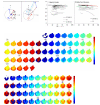Spontaneous spatiotemporal waves of gene expression from biological clocks in the leaf
- PMID: 22496591
- PMCID: PMC3340055
- DOI: 10.1073/pnas.1118814109
Spontaneous spatiotemporal waves of gene expression from biological clocks in the leaf
Abstract
The circadian clocks that drive daily rhythms in animals are tightly coupled among the cells of some tissues. The coupling profoundly affects cellular rhythmicity and is central to contemporary understanding of circadian physiology and behavior. In contrast, studies of the clock in plant cells have largely ignored intercellular coupling, which is reported to be very weak or absent. We used luciferase reporter gene imaging to monitor circadian rhythms in leaves of Arabidopsis thaliana plants, achieving resolution close to the cellular level. Leaves grown without environmental cycles for up to 3 wk reproducibly showed spatiotemporal waves of gene expression consistent with intercellular coupling, using several reporter genes. Within individual leaves, different regions differed in phase by up to 17 h. A broad range of patterns was observed among leaves, rather than a common spatial distribution of circadian properties. Leaves exposed to light-dark cycles always had fully synchronized rhythms, which could desynchronize rapidly. After 4 d in constant light, some leaves were as desynchronized as leaves grown without any rhythmic input. Applying light-dark cycles to such a leaf resulted in full synchronization within 2-4 d. Thus, the rhythms of all cells were coupled to external light-dark cycles far more strongly than the cellular clocks were coupled to each other. Spontaneous desynchronization under constant conditions was limited, consistent with weak intercellular coupling among heterogeneous clocks. Both the weakness of coupling and the heterogeneity among cells are relevant to interpret molecular studies and to understand the physiological functions of the plant circadian clock.
Conflict of interest statement
The authors declare no conflict of interest.
Figures





References
-
- McWatters HG, Devlin PF. Timing in plants—a rhythmic arrangement. FEBS Lett. 2011;585:1474–1484. - PubMed
-
- Plautz JD, Kaneko M, Hall JC, Kay SA. Independent photoreceptive circadian clocks throughout Drosophila. Science. 1997;278:1632–1635. - PubMed
-
- Thain SC, Hall A, Millar AJ. Functional independence of circadian clocks that regulate plant gene expression. Curr Biol. 2000;10:951–956. - PubMed
Publication types
MeSH terms
Grants and funding
LinkOut - more resources
Full Text Sources
Other Literature Sources

